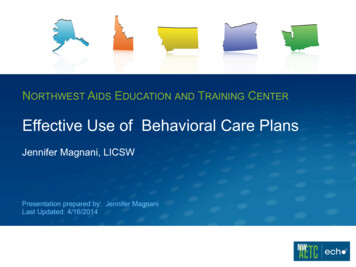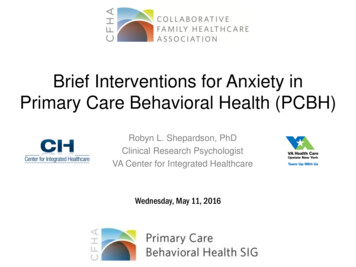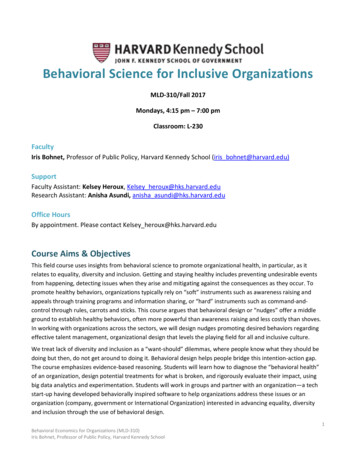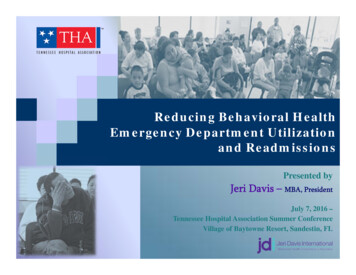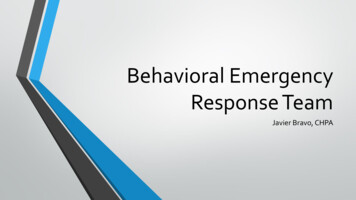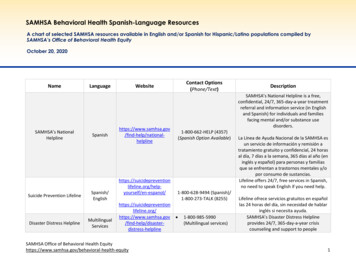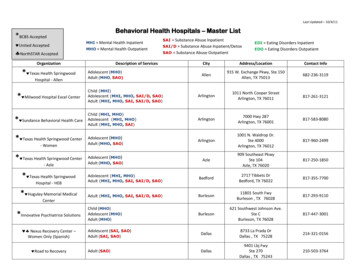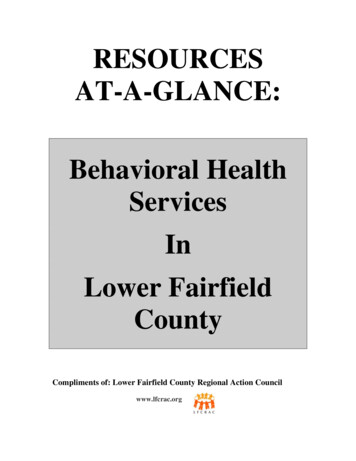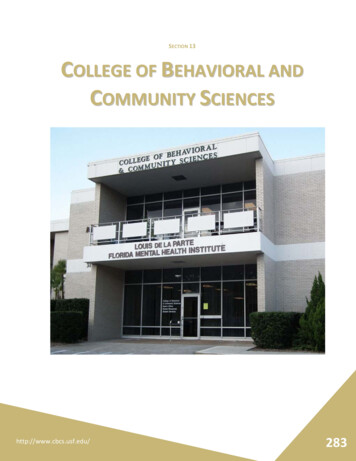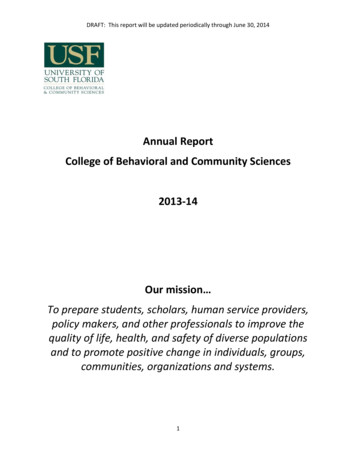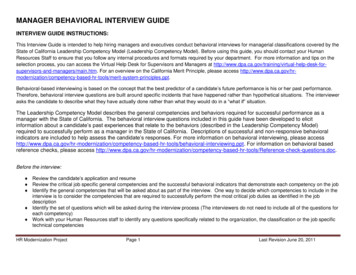
Transcription
MANAGER BEHAVIORAL INTERVIEW GUIDEINTERVIEW GUIDE INSTRUCTIONS:This Interview Guide is intended to help hiring managers and executives conduct behavioral interviews for managerial classifications covered by theState of California Leadership Competency Model (Leadership Competency Model). Before using this guide, you should contact your HumanResources Staff to ensure that you follow any internal procedures and formats required by your department. For more information and tips on theselection process, you can access the Virtual Help Desk for Supervisors and Managers at orsupervisors-and-managers/main.htm. For an overview on the California Merit Principle, please access al-based interviewing is based on the concept that the best predictor of a candidate’s future performance is his or her past performance.Therefore, behavioral interview questions are built around specific incidents that have happened rather than hypothetical situations. The interviewerasks the candidate to describe what they have actually done rather than what they would do in a ―what if‖ situation.The Leadership Competency Model describes the general competencies and behaviors required for successful performance as amanager with the State of California. The behavioral interview questions included in this guide have been developed to elicitinformation about a candidate’s past experiences that relate to the behaviors (described in the Leadership Competency Model)required to successfully perform as a manager in the State of California. Descriptions of successful and non-responsive behavioralindicators are included to help assess the candidate’s responses. For more information on behavioral interviewing, please tency-based-hr-tools/behavioral-interviewing.ppt. For information on behavioral basedreference checks, please access e the interview: Review the candidate’s application and resume Review the critical job specific general competencies and the successful behavioral indicators that demonstrate each competency on the job Identify the general competencies that will be asked about as part of the interview. One way to decide which competencies to include in theinterview is to consider the competencies that are required to successfully perform the most critical job duties as identified in the jobdescription Identify the set of questions which will be asked during the interview process (The interviewers do not need to include all of the questions foreach competency) Work with your Human Resources staff to identify any questions specifically related to the organization, the classification or the job specifictechnical competenciesHR Modernization ProjectPage 1Last Revision June 20, 2011
Tips for customizing this Interview Guide for your interviews: To obtain a customizable version of this guide, please contact us.Once you receive the copy, use the ―File Save As‖ feature.Edit the document so that it includes only the job related general competencies that you have identified for inclusion in your interviews.Edit the document so that the set of behavioral interview questions provided for each general competency include only those questions thatyou have identified for inclusion in your interviews.Edit the document so that it includes only the successful and non-responsive behavioral indicators that you expect to be elicited based onthe selected competency questions.Add any questions specifically related to the organization, the classification or the job specific technical competencies along with theexpected successful and non-responsive behavioral indicators.Make a copy of the interview guide for each interviewer to use to take notes on each candidate to be interviewed.On the interview guide for each candidate each interviewer should fill in the following information:o The interview information (i.e. candidate name, interviewer name, interview date, position being filled)o The Education and Experience from the candidate’s application (during the interview, notes can be added based on what thecandidate shares about their education and experience)Conducting the interview: Welcome the candidate and make them comfortableProvide the candidate with a copy of the questions that will be asked in the interview (optional)Begin the formal interview by briefly reviewing the candidate’s education and experienceAsk the same questions of each candidate being interviewed for the same positionTell the candidate about the job and the organizationClarify any questions about the candidates education and work experience that are necessary (i.e. fill in gaps)Ask questions and follow-up to probe for details and accomplishments—ideally at least 2–3 examples in each area. Get complete exampleswhich include:The circumstances that the candidate encounteredThe actions that the candidate tookThe outcome of the actions taken Use this guide to take notes and assess the candidates – Exceptional performance in the interview or performance in the interview that doesnot meet expectations must be indicated in the notes section of the interview guide for a particular question and competency. Select the appropriate behavioral indicators based on the candidate’s responses and summarize key observations and notes. Rate thecandidate on each competency in the space provided at the bottom of each page.HR Modernization ProjectPage 2Last Revision June 20, 2011
After the interview: After completing each interview, interviewers should discuss the final ratings for each candidate and complete the Overall Candidate Rating. After all interviews are completed, check references, check personnel files; make hiring decision.Candidate Name:Interviewer Name:Interview Date:Position Being Filled:HR Modernization ProjectPage 3Last Revision June 20, 2011
EDUCATION AND EXPERIENCEEducation:Experience:HR Modernization ProjectPage 4Last Revision June 20, 2011
Behavioral Interview QuestionsFOSTERING A TEAM ENVIRONMENT CLUSTERCommunication Questions Describe a time when you realized you needed to make an improvement in your communication skills and how you managed it.o What did you do?o What was the outcome?Describe a situation in which you had to provide input to an organization-wide project.o What was the input?o Who did you provide input to?o What type of impact did the input have?o How was the input received?o What was the result?Describe a situation which demonstrated that listening is an important aspect of leadership.o What did you do?o What was the result?o Why was listening important in this situation?Give us an example of when your listening skills helped resolve a situation or issue.o How did you show you were listening?o What impact did your listening skills have on the outcome of the situation or issue and why?Describe a time when you were able to effectively communicate a difficult or unpleasant idea to staff, stakeholders or senior management.o What was the situation?o What was the outcome?Describe a situation where you successfully persuaded others to do something or to see your point of view.o What was the situation?o What did you do?o What was the result?HR Modernization ProjectPage 5Last Revision June 20, 2011
Communication Questions (Continued) Describe a situation when you had to present complex information which included technical concepts and terminology.o How did you ensure that the audience understood?o What was the result?Describe what you have done to ensure that there is a clear understanding of the importance of sharing and receiving information fromothers.o What did you do?o Why was this necessary?o What did this achieve?Describe what you have done to enhance the quality of written documents from your staff.o What did you do?o What challenges did you face?o What was the outcome?Describe the process you have used to review and approve written correspondence from your staff.o What steps did you take?o What did you look for before approving the correspondence?Conveying complex messages in writing may require the creative use of graphics and other visual aids. Provide us with an example of whenyou mentored staff on effectively conveying complex ideas in writing in an accurate, clear, and concise manner that could be easilyunderstood by the audience.o What was the situation?o What did you do?o What was the outcome?HR Modernization ProjectPage 6Last Revision June 20, 2011
Competency:Communication Gives feedback andis receptive tofeedback received Knows that listeningis essential Keeps othersinformed andensures is passed toothers appropriately Uses a variety ofmethods to ensureinformation isconveyed Strives for error-freecommunications Expresses clear andconcise ideas inwriting Organizes writtenideas Uses graphics andother aids to clarifyideasSuccessful Behavioral Indicators (Validated)Non-Responsive Behavioral Indicators Has solicited regular input from a variety of sources Has provided regular feedback across the organization Has fostered a culture of active listening Has coached others on listening Has sought out and carefully listened to others and madedecisions based on stated facts Has clearly communicated difficult messages Has influenced the opinions of teams, stakeholders, leadersand executives Has adapted the communication style to the various audiences Has championed information sharing by establishing,implementing and monitoring processes to disseminate andgather key information to and from all relevant stakeholders Has established, defined and ensured compliance withdepartment writing style and standards Has set and communicated expectations for written expressionand style to staff Has worked to raise expectations for written expression withstaff Has managed staff performance against department writingstyle and standards Has approved and signed off on internal and externalcommunications after ensuring document quality standards aremet and ensuring compliance with regulations Has coached others on developing creative visual aids andgraphics to simplify complex messages to stakeholders Did not indicate that they have solicited regular input from a varietyof sources Did not indicate that they have provided regular feedback acrossthe organization Did not indicate that they have fostered a culture of active listening Did not indicate that they have coached others on listening Did not indicate that they have sought out and carefully listened toothers and made decisions based on stated facts Did not indicate that they have clearly communicated difficultmessages Did not indicate that they have influenced the opinions of teams,stakeholders, leaders and executives Did not indicate that they have adapted the communication style tothe various audiences Did not indicate that they have championed information sharing byestablishing, implementing and monitoring processes todisseminate and gather key information to and from all relevantstakeholders Did not indicate that they have established, defined and ensuredcompliance with department writing style and standards Did not indicate that they have set and communicatedexpectations for written expression and style to staff Did not indicate that they have worked to raise expectations forwritten expression with staff Did not indicate that they have managed staff performance againstdepartment writing style and standards Did not indicate that they have approved and signed off on internaland external communications after ensuring document qualitystandards are met and ensuring compliance with regulations Did not indicate that they have coached others on developingcreative visual aids and graphics to simplify complex messages tostakeholdersOVERALL RATING FOR COMMUNICATION Did Not Meet (Notes Required)Notes SuccessfulExceptional (Notes Required) HR Modernization ProjectPage 7Last Revision June 20, 2011
Conflict Management Questions Describe a situation in which you identified a potential conflict in your organization.o How did you go about identifying the potential conflict?o What factors did you consider?o What actions did you take?o What was the outcome?Tell us about a time when you had to help other leaders resolve a conflict in your organization.o What did you do?o What was the result?Revolving conflicts expeditiously, effectively and at the lowest possible level is often the best approach. Tell us about a specific exampleof how you have ensured that conflicts are resolved expeditiously, effectively and at the lowest possible level in your branch or division.o What was the situation?o What did you do?o What was the result?HR Modernization ProjectPage 8Last Revision June 20, 2011
Competency: ConflictManagement Recognizes differencesin opinions andmisunderstandings andencourages opendiscussion Uses appropriateinterpersonal styles Finds agreement onissues Deals effectively withothers in antagonisticsituationsSuccessful Behavioral Indicators(Validated)Non-Responsive Behavioral Indicators Has provided conflict resolution guidance toother leaders Has developed innovative methods for conflictprevention Has led others in the use of differentinteraction methods for various interpersonalstyles Has used knowledge of various interpersonalstyles to further team’s mission Has fostered an environment that promotedrapid identification and resolution of potentialconflicts Has anticipated, diffused and mitigatedpotential conflicts Has monitored the work environment to avoidpotential conflicts Has set expectations for handling conflicts Has mentored and coached others on conflictresolution management Has ensured that appropriate polices andexpectations regarding conflict resolution exist Has verified compliance with laws, policiesand established practices in regard to conflictresolution Did not indicate that they have provided conflictresolution guidance to other leaders Did not indicate that they have developed innovativemethods for conflict prevention Did not indicate that they have led others in the use ofdifferent interaction methods for various interpersonalstyles Did not indicate that they have used knowledge ofvarious interpersonal styles to further team’s mission Did not indicate that they have fostered an environmentthat promoted rapid identification and resolution ofpotential conflicts Did not indicate that they have anticipated, diffused andmitigated potential conflicts Did not indicate that they have monitored the workenvironment to avoid potential conflicts Did not indicate that they have set expectations forhandling conflicts Did not indicate that they have mentored and coachedothers on conflict resolution management Did not indicate that they have ensured that appropriatepolices and expectations regarding conflict resolutionexist Did not indicate that they have verified compliance withlaws, policies and established practices in regard toconflict resolutionOVERALL RATING FOR CONFLICT MANAGEMENT Did Not Meet (Notes Required)Successful Exceptional (Notes Required) Notes HR Modernization ProjectPage 9Last Revision June 20, 2011
Interpersonal Skills Questions Tell us about a situation when you had to vary your communication approach according to the audience that you were addressingand the type of information you were sharing.o What was the situation?o What did you do?o What factors did you consider when developing your communication approach?o What was the result?Describe a situation in which you were able to effectively "read" others and guide your actions by your understanding of their nonverbal cues.o What did you do?o What was the outcome of the situation?Tell us about a time when you and your team members were dealing with a stressful work situation.o What was the situation?o How did you handle it?o What was the outcome?o Were you satisfied with the outcome, why or why not?Tell us about a time when you had to coach staff on presenting sensitive or complex information in a manner that could be easilyunderstood.o What did you do?o What was the outcome?o What techniques did you teach staff to use to confirm that the audience understood the presentation?Tell us about a situation when you withheld your own opinion, and tried to obtain the opinion of others.o What did you do?o What was the outcome?o Why was this action important?HR Modernization ProjectPage 10Last Revision June 20, 2011
Interpersonal Skills Questions (Continued) Tell us about what you have done to improve the knowledge, skills and abilities of your staff.o What did you do?o What was the outcome? Tell us about a specific example of how you have helped create an environment where information can be shared in an appropriateand professional manner.oWhat was the situation?oWhat did you do?oWhat was the outcome?HR Modernization ProjectPage 11Last Revision June 20, 2011
Competency: InterpersonalSkills Effectively approachesothers with sensitiveinformation Understands the unspokenmeaning of a situation Understands strengths anddevelopment areas of others Makes others feel respectedand heardSuccessful Behavioral Indicators(Validated)Non-Responsive Behavioral Indicators Has used a variety of strategies to communicateinformation to various audiences, particularly insensitive situations, while maintaining aprofessional approach and positive image Has considered the organizational culture whendeveloping and applying the appropriatecommunication style Has mentored others on adapting their personalstyle to fit the situation Has effectively assessed and responded to nonverbal cues and unspoken complex sub-messages Has led others in the development of theirperception skills Has recognized one’s own and staff’s stressors Has led others in the use of appropriate tools andtechniques to effectively address stressfulsituations Has matched others to jobs suited to their strengthsand development needs Has built an environment that supports staffdevelopment Has modeled active listening skills Has ensured people feel they are heard andunderstood Has ensured a ―safe‖ communication environmentwhere information can be sought out andexchanged effectively Did not indicate that they have used a variety of strategies tocommunicate information to various audiences, particularly insensitive situations, while maintaining a professional approachand positive image Did not indicate that they have considered the organizationalculture when developing and applying the appropriatecommunication style Did not indicate that they have mentored others on adapting theirpersonal style to fit the situation Did not indicate that they have effectively assessed andresponded to non-verbal cues and unspoken complex submessages Did not indicate that they led others in the development of theirperception skills Did not indicate that they have recognized one’s own and staff’sstressors Did not indicate that they have led others in the use ofappropriate tools and techniques to effectively address stressfulsituations Did not indicate that they have matched others to jobs suited totheir strengths and development needs Did not indicate that they have built an environment thatsupports staff development Did not indicate they have modeled active listening skills Did not indicate that they have ensured people feel they areheard and understood Did not indicate that they have ensured a ―safe‖ communicationenvironment where information can be sought out andexchanged effectivelyOVERALL RATING FOR INTERPERSONAL SKILLS Did Not Meet (Notes Required)Successful Exceptional (Notes Required) Notes HR Modernization ProjectPage 12Last Revision June 20, 2011
Team Leadership Questions Tell us about a time when you managed or guided a group or team effort.o What was the situation?o What actions did you take?o What were the biggest challenges and how did you overcome them?o What steps did you take to achieve a positive outcome?o How did the group or team effort ultimately turn out?Competency: TeamLeadership Sets team structure Organizes, leads, andfacilitates teamactivities Promotes teamcooperation EncouragesparticipationSuccessful Behavioral Indicators(Validated)Non-Responsive Behavioral Indicators Has communicated progress to stakeholders Has communicated objectives to the team leader Has anticipated team and stakeholderchallenges and planned contingencies Has engaged internal and external teammembers to manage conflicts effectively Has known when to escalate issues Has served as a role model in promoting teamwork and respect within both internal andexternal teams Has led teams in tackling the toughestchallenges Has closely managed team performance Has celebrated team successful performance Did not indicate that they have communicated progress tostakeholders Did not indicate that they have communicated objectives tothe team leader Did not indicate that they have anticipated team andstakeholder challenges and planned contingencies Did not indicate that they have engaged internal and externalteam members to manage conflicts effectively Did not indicate that they have known when to escalateissues Did not indicate that they have served as a role model inpromoting team work and respect within both internal andexternal teams Did not indicate that they have led teams in tackling thetoughest challenges Did not indicate that they have closely managed teamperformance Did not indicate that they have celebrated team successfulperformanceOVERALL RATING FOR TEAM LEADERSHIP Did Not Meet (Notes Required) SuccessfulExceptional (Notes Required) Notes HR Modernization ProjectPage 13Last Revision June 20, 2011
CREATING ORGANIZATIONAL TRANSFORMATION CLUSTERChange Leadership Questions Tell us about an experience you have had implementing change in an organization.o How did you do this?o What was the outcome?o What were the challenges and regrets?Tell us about a project or situation where you felt that the conventional approach would not be suitable.o How did you determine this?o How did you derive and manage a new approach?o What challenges did you face and how did you address them?Describe a situation where you fostered a highly motivated and productive work environment during times of change.o What did you do?o What was the result?o What challenges did you face?Describe a situation where you had to assist others in adapting to a change which was out of your control.o What did you do?o What challenges did you face?o How did you overcome these challenges?HR Modernization ProjectPage 14Last Revision June 20, 2011
Competency: ChangeLeadership Develops newapproaches Identifies better, fasteror less expensive waysto do things Encourages others tovalue the potentialbenefits of change andto effectively adapt tochangeSuccessful Behavioral Indicators(Validated)Non-Responsive Behavioral Indicators Has successfully led difficult change effortswith broad impact Has worked with executive leaders and/orstakeholders to overcome obstacles Has generated innovative ideas that arestrategically aligned with department goals Has served as a change agent Has created a positive environment ofexcitement around the potential benefits ofchange Has supported the management team’s effortsto adapt to change by facilitating the flow ofinformation Did not indicate that they have successfully led difficultchange efforts with broad impact Did not indicate that they have worked with executiveleaders and/or stakeholders to overcome obstacles Did not indicate that they have generated innovative ideasthat are strategically aligned with department goals Did not indicate that they have served as a change agent Did not indicate that they have created a positiveenvironment of excitement around the potential benefitsof change Did not indicate that they have supported themanagement team’s efforts to adapt to change byfacilitating the flow of informationOVERALL RATING FOR CHANGE LEADERSHIP Did Not Meet (Notes Required)Successful Exceptional (Notes Required) Notes HR Modernization ProjectPage 15Last Revision June 20, 2011
Vision and Strategic Thinking Questions Give us an example of when you had to communicate the organization’s vision and strategic plan with conviction, translate theorganization’s strategy into meaningful plans for the future and connect them to the employee’s daily work.o What was the situation?o What did you do?o How did you involve your staff or team?o What was the outcome?Describe a time when you had to significantly modify work policies to align them with new strategic directives.o What was the situation?o What did you do?o What was the outcome?Competency: Vision andStrategic Thinking Communicates the bigpicture Expresses vision toothers Influences others totranslate vision intoactionSuccessful Behavioral Indicators(Validated)Non-Responsive Behavioral Indicators Has integrated the department’s longer termvision into all aspects of the organization Has encouraged implementation of thedepartment’s vision through strategic goalsand policies Has established an environment that supportsthe departmental vision through integrationand coordination of significant team activities Has effectively communicated the strategicvalue of the departmental vision tostakeholders, staff and high-level audiences Has set goals to put the vision into actionthrough policies and procedures Did not indicate that they have integrated thedepartment’s longer term vision into all aspects of theorganization Did not indicate that they have encouragedimplementation of the department’s vision throughstrategic goals and policies Did not indicate that they have established anenvironment that supports the departmental visionthrough integration and coordination of significant teamactivities Did not indicate that they have effectively communicatedthe strategic value of the departmental vision tostakeholders, staff and high-level audiences Did not indicate that they have set goals to put the visioninto action through policies and proceduresOVERALL RATING FOR VISION AND STRATEGIC THINKING Did Not Meet (Notes Required)Successful NotesHR Modernization ProjectExceptional (Notes Required) Page 16Last Revision June 20, 2011
MAXIMIZING PERFORMANCE RESULTS CLUSTERAnalytical Thinking Questions Describe a situation in which you were able to clearly frame a problem, identify and collect the necessary data, and make recommendationsfor solving the problem.o What was the problem?o Who was impacted by the problem?o What factors or variables did you consider?o What did you do?o How did you evaluate your options?o What was the outcome?Describe a time you had to delegate parts of a large project or assignment to some of your direct reports.o How did you decide what tasks to delegate to which people?o How did the project or assignment turn out?Give us an example of a time when you used your fact-finding skills to gain information needed to solve a problem.o How did you analyze the information you gathered?o How did you use the information to solve the problem?Describe a time when you anticipated potential problems that were significant to the organization and developed preventive measures.o What was the potential problem?o How did you identify the potential problem?o What was the potential impact on the organization?o What did you do?o What was the outcome?HR Modernization ProjectPage 17Last Revision June 20, 2011
Competency: AnalyticalThinking Identifies causes forproblems Approaches problemsby breaking them down Weighs priorities Recognizes actions andunderlying issuesSuccessful Behavioral Indicators(Validated)Non-Responsive Behavioral Indicators Has identified causes for problems related topolicy or global issues Has broken down significantly complexproblems that affected several teams Has delegated work to other supervisors Has developed findings, recommendations,and potential solutions for a variety ofaudiences that are supported by soundtechnical rationale Has asked effective probing questions Has exhibited the ability to synthesizeinformation from supervisors and otherrelevant sources Has recognized and prioritized organizationalkey actions at the branch/division level Has anticipated significant organizational keyactions and underlying issues at thebranch/division or higher level Did not indicate that they have identified causes forproblems related to policy or global issues Did not indicate that they have broken down significantlycomplex problems that affected several teams Did not indicate that they have delegated work to othersupervisors Did not indicate that they have developed findings,recommendations, and potential solutions for a variety ofaudiences that are supported by sound technicalrationale Did not indicate that they have asked effective probingquestions Did not indicate that they have exhibited the ability tosynthesize information from supervisors and otherrelevant sources Did not indicate that they have recognized and prioritizedorganizational key actions at the branch/division level Did not indicate that they have anticipated significantorganizational key actions and underlying issues at thebranch/division or higher levelOVERALL RATING FOR ANALYTICAL THINKING Did Not Meet (Notes Required)Successful Exceptional (Notes Required) Notes HR Modernization ProjectPage 18Last Revision June 20, 2011
Customer Focus Questions Describe how you established a partnership with an internal and/or external customer to help you both achieve your strategic businessgoals.o What did you do?o What was the outcome?Tell us what you have done to establish a cus
Jun 20, 2011 · Behavioral-based interviewing is based on the concept that the best predictor of a candidate’s future performance is his or her past performance. Therefore, behavioral interview
